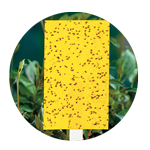Whiteflies or whiteflies

Definition
There are two species of whiteflies: B. tabaci and T. vaporariorum. They are distinguished mainly by the position of the wings. In B. tabaci, the wings are attached to the body, whereas in T. vaporariorum, the wings are parallel to the leaf surface. In addition, waxy powder is generally more abundant on adult T. vaporariorum than B. tabaci.
Whiteflies are hemipteroid insects belonging to the family Aleyrodidae (whiteflies). They can cause significant damage to crops. Whiteflies are tiny but nevertheless very visible, because they have the curious habit of flying all around the infested plant when they are disturbed and land immediately on the same plant or on a neighboring one: they look like little flying dandruff.
Proliferation of whiteflies

The complete life cycle of whiteflies lasts from 15 to 40 days, depending on the environmental conditions, especially the temperature, since the eggs develop into adults more quickly if the temperature is high. Whiteflies usually lay their eggs under leaves where the eggs stick.
White flies suck sap, and secrete substances that are toxic to the plant.
Symptoms

Discolored spots appear on the leaves that have served as a meal: Chlorosis, general weakening, and flowers and fruits change.
there is direct damage due to the fact that the plant feeds on the leaves and indirect damage: the honeydew excreted by the nymphs allows fungi such as fumagine (Capnodium sp.) to form on the leaves. Its stings do not cause much damage, but fumago, a microscopic fungus that settles on the attacked parts, depreciates the fruits and weakens the plants. Some whiteflies can transmit dangerous viruses.
Virus transmission remains the most serious damage caused to crops by whiteflies.
How to control whiteflies?

One of the main objectives of whitefly control is to avoid infection of the crop by an insect-borne virus.
Clean the plant well (remove undesirable weeds that are hiding places for white flies). Also, if a white fly feeds on a virus-carrying weed and then eventually reaches your crop, the virus can spread quickly. The use of protective barriers such as netting and covers are also good options for preventing infestations.
Whiteflies also have a little flaw that you can take advantage of: they are attracted to the color yellow. In nature, yellow signals a plant that is not in good shape and therefore not likely to defend itself against an attack: a real haven for whiteflies.
Place yellow sticky signs at the entrance of the greenhouse. It would also be useful to install anti-insect nets on the openings of the greenhouse and a double door with an airlock lined with yellow panels.
You can also find insect repellents and treatments on Culture Indoor.
Biological control
A variety of entomophagous insects, parasites and pathogenic fungi are used to control whiteflies. Most of the predators used feed on whitefly eggs and nymphs. In this category, the ladybug Delphastus catalinae is a good example. Lacewing larvae and some bed fleas are also good biological control methods for this pest. Small wasps of the Aphelinae family are parasites of whitefly larvae. They lay their eggs inside the larvae and feed on them to develop.
